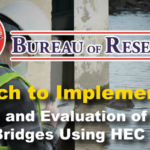This Research to Implementation video presents an example of NJDOT-sponsored research and the effect such research has in addressing transportation-related issues within the State.
Bridge scour is the removal of sediment such as sand and gravel from around non-tidal bridge substructures and supports caused by swiftly moving water. This water can scoop out scour holes, compromising the integrity of a structure. Understanding the extent of bridge damage and prioritizing the order of repair is critical to maintaining safe bridges.
With the support of NJDOT's Bureau of Research, researchers developed the NJ-specific Scour Evaluation Model (SEM) to prioritize bridges for repair. The SEM model was determined to be effective and is now approved by FHWA and NJDOT to evaluate scour risk. The project included training of consultants to encourage the expanded use of the SEM model in NJ.
The video promotes the benefits of funded research to increase the safety of the traveling public, reduce costs, and increase efficiency.

